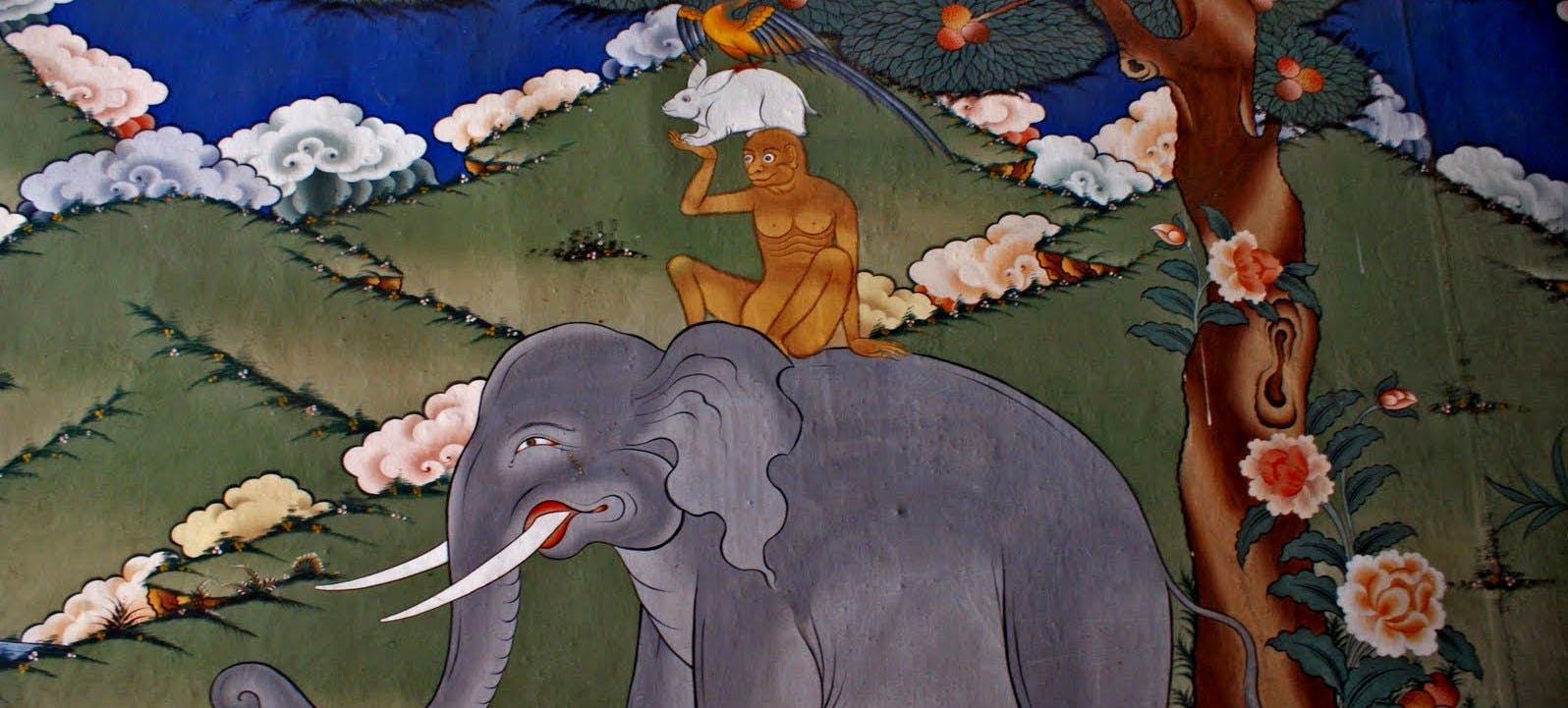Discover the vibrant world of Local Handicrafts of Bhutan as you explore the rich tapestry of Traditional Bhutanese Crafts that capture the spirit and cultural heritage of this serene Himalayan kingdom. Experience a diverse array of unique and exquisite handicrafts, from the intricately woven Bhutan Textiles Online to the spiritually significant Thangka Paintings, each telling a story of age-old traditions and skilled artisanship. Dive into the realms of Bhutanese Woodwork, Bamboo Crafts, and Handmade Bhutanese Paper, all showcasing sustainable practices deeply rooted in Bhutanese culture. Whether you're looking to Buy Thangka Paintings, admire Bhutanese Metalwork Art, or explore Bhutan Art and Craft Markets for Authentic Bhutanese Souvenirs, our expertly guided tours offer an immersive experience into the artful heart of Bhutan.
Amen Bhutan Tours and Treks is the best company to explore the Local Handicrafts of Bhutan. With expert guides and deep connections to the artisan communities, they provide unparalleled access to the rich tapestry of Traditional Bhutanese Crafts. Whether you're interested in the intricate Bhutan Textiles Online, the spiritual art of Thangka Paintings, or other authentic handicrafts like Bhutanese Woodwork and Handmade Bhutanese Paper, Amen Bhutan Tours and Treks offers immersive tours that highlight the best of Bhutan's artistic heritage. Their dedication to providing a comprehensive cultural experience makes them a top choice for anyone looking to delve into the world of Bhutanese crafts.
Bhutan Textiles
Bhutan Textiles are renowned worldwide for their exquisite craftsmanship, vibrant colors, and intricate designs, representing a pivotal element of Bhutan's rich cultural heritage. Here are some key highlights of Bhutanese textiles:
.jpg)
- Materials and Techniques: Bhutanese weavers use high-quality materials like raw silk, cotton, and wool. The weaving techniques are intricate and varied, often specific to particular regions or clans. Each pattern and color scheme has cultural significance and is often passed down through generations.
- Traditional Attire: Textiles are most prominently used in traditional Bhutanese clothing, such as the Kira for women and the Gho for men. These garments are not only everyday attire but also important symbols of Bhutanese identity and pride.
- Yathra Weaving: A distinctive form of Bhutanese textile, Yathra is characterized by its vibrant patterns and colors, woven primarily in the Bumthang district. It is made from sheep’s wool and is used for a variety of products, from clothing to decorative items.
- Brocade Weaving: This is a high-end, intricate weaving technique used mainly for religious purposes and royal ceremonies. Brocade textiles often incorporate gold and silver threads, making them highly valued and prestigious.
- Cultural Significance: Textiles play a crucial role in Bhutanese rituals and ceremonies, including weddings, religious functions, and national festivals. They are considered expressions of art that encapsulate the spiritual and historical essence of Bhutan.
- Artisan Support: The government and various NGOs support textile artisans through training programs and initiatives that help preserve and promote this traditional art form. This includes fostering market access and innovation in designs while maintaining traditional methods.
- Tourism and Economy: Bhutanese textiles are a key attraction for tourists, who purchase them as luxurious souvenirs and unique pieces of art. This significantly contributes to the local economy and helps sustain the traditional weaving practices.
Bhutanese textiles are much more than fabric; they are a woven narrative of Bhutan's history, culture, and artistry, cherished both within the kingdom and by enthusiasts around the globe.
Thangka Paintings
Thangka Paintings are a unique and spiritually significant form of art in Bhutan, deeply intertwined with the practices and teachings of Buddhism. Here are the key highlights of Thangka paintings:

- Spiritual Significance: Thangkas are more than just art; they serve as important aids in meditation and teaching, providing a visual representation of the teachings of Buddha. The images in Thangkas are used to help devotees visualize certain deities or concepts, aiding in their spiritual practices.
- Artistic Detail: These paintings are known for their intricate detail and vibrant colors. Artists use natural pigments derived from minerals and plants, which contribute to the rich and vivid colors that are characteristic of Thangka paintings. Each piece can take several weeks to several months to complete, depending on the complexity of the design.
- Iconography: Thangkas depict various Buddhist deities, scenes from the life of Buddha, and complex cosmological scenes. Each element in a Thangka, from the gestures of the figures to the smallest detail in the background, has a specific symbolic meaning.
- Techniques and Styles: The creation of a Thangka involves several precise and traditional techniques. The process starts with preparing a mixture of chalk, gesso, and glue to create a smooth painting surface. The artist then sketches the design and carefully paints the figures and symbols using fine brushes.
- Cultural Preservation: Thangka painting is a revered tradition in Bhutan and is considered a way to preserve religious and cultural heritage. It is taught from master to apprentice, ensuring that the skills and spiritual teachings are passed down through generations.
- Economic Impact: Thangka paintings are highly valued both within Bhutan and internationally. They are sought after by collectors and practitioners of Buddhism, providing a significant source of income for the artisans who create them.
- Tourist Attraction: For visitors to Bhutan, observing the creation of Thangkas and purchasing them can be a highlight of their trip, offering a deep insight into Bhutanese culture and spirituality.
Thangka paintings are a cornerstone of Bhutanese artistic and religious expression, representing a confluence of devotion, art, and heritage that is cherished both locally and globally.
Woodwork and Carpentry
Woodwork and Carpentry in Bhutan are integral components of the nation's cultural heritage, blending artistry with utility in ways that are both functional and aesthetically pleasing. Here are the key highlights of Bhutanese woodwork and carpentry:
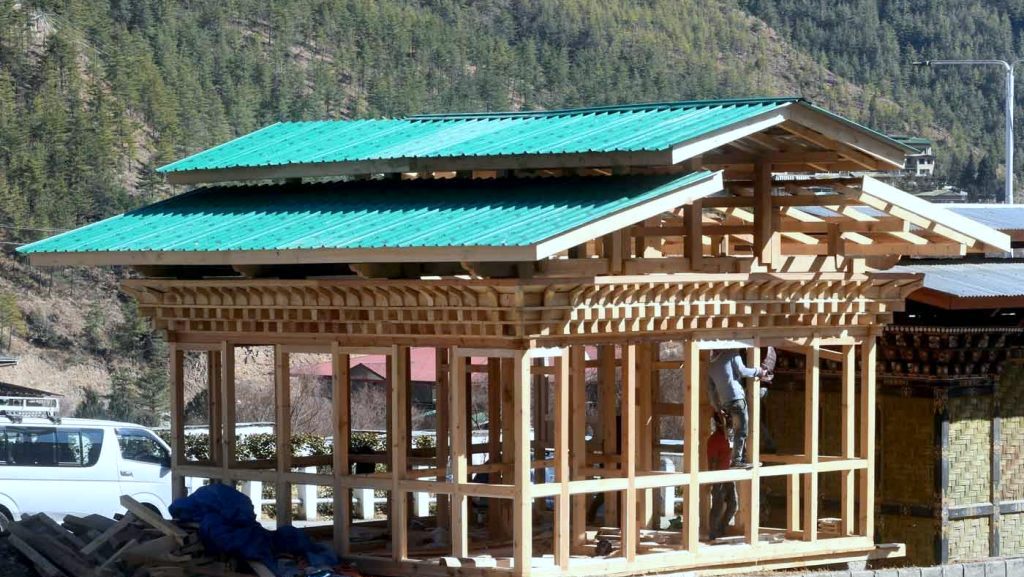
- Architectural Significance: Woodwork is a standout feature in Bhutanese architecture, particularly visible in the construction of dzongs (fortresses), temples, traditional houses, and monasteries. Intricate wooden beams, panels, and cornices are not only structural but also serve as elaborate decorative elements.
- Carving Artistry: Bhutanese carpenters are renowned for their skill in wood carving, creating detailed motifs that often depict religious and mythological themes, such as dragons, phoenixes, and other auspicious symbols. These carvings are typically found on windows, doors, and furniture, each piece telling a part of Bhutan’s rich folklore.
- Traditional Techniques: The techniques used in Bhutanese woodwork are passed down through generations within artisan families. These methods are traditionally manual, involving hand tools and minimal mechanization, which reflects a deep respect for maintaining heritage and craftsmanship.
- Sustainability Practices: Wood used in Bhutanese carpentry is often sourced from local forests, with a strong emphasis on sustainability. The government and various community initiatives promote responsible harvesting practices to ensure that this craft is environmentally sustainable.
- Religious and Cultural Integration: Woodwork in Bhutan is deeply intertwined with the country's religious practices. Many woodcrafts are intended for use in religious ceremonies, including the creation of altars, ritual masks, and statues. The art is seen as a form of spiritual devotion and a way to honor Bhutanese traditions.
- Preservation and Education: Efforts to preserve woodcraft skills include formal training programs and apprenticeships that encourage the younger generation to continue this traditional art. These programs are essential for sustaining the cultural identity and craftsmanship of Bhutan.
- Economic Impact: The woodcraft industry is a significant part of the local economy, providing employment and income for many Bhutanese families. It also adds value to the tourism sector, as visitors are keen to purchase unique wooden artifacts as souvenirs.
Bhutanese woodwork and carpentry not only showcase the country's exceptional craftsmanship but also reflect the spiritual and cultural ethos that is central to the Bhutanese way of life. This craft is a beautiful expression of Bhutan’s heritage, making it a cherished aspect of their national identity.
Bamboo Crafts
Bamboo Crafts in Bhutan represent a perfect amalgamation of traditional skills and environmental consciousness, using the versatile and sustainable resource of bamboo. Here are the key highlights of Bhutanese bamboo crafts:
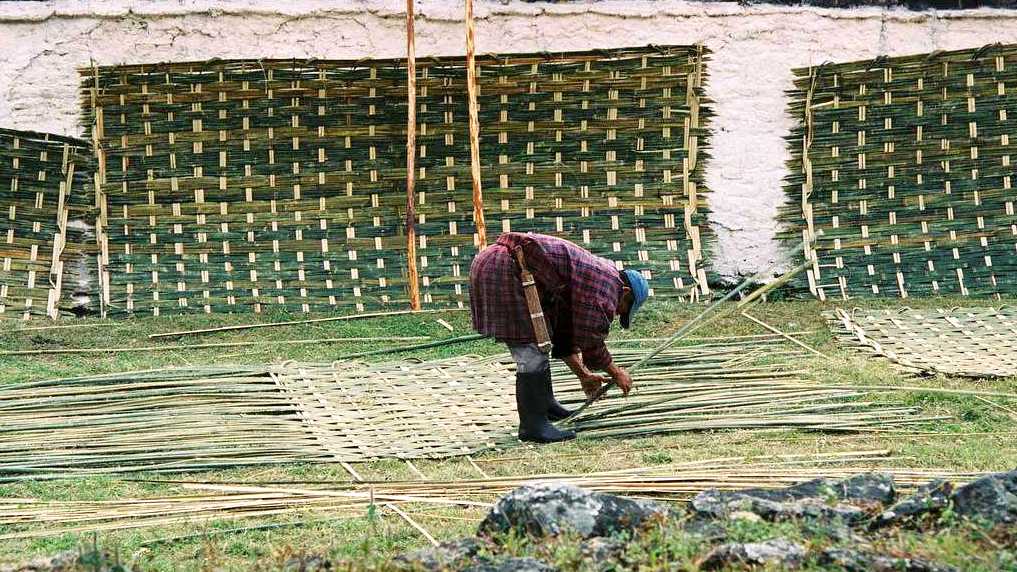
- Versatility of Bamboo: Bamboo is extensively used in Bhutan due to its abundance and flexibility. It is crafted into a wide range of products, from utilitarian items like baskets, mats, and utensils to more intricate items such as musical instruments, furniture, and even structural elements in houses.
- Sustainable Crafting: Bamboo is a highly sustainable material due to its fast growth rate and renewability. The use of bamboo in crafts reflects Bhutan's deep commitment to environmental conservation and sustainable development practices.
- Artisan Skill: Crafting bamboo requires a high degree of skill, which has been developed and refined over generations. Bhutanese artisans are adept at manipulating bamboo into various shapes and forms, showcasing their detailed knowledge of the material’s properties.
- Cultural Significance: Bamboo crafts are not just functional; they are also imbued with cultural significance. Items like bamboo bows and arrows, for instance, play a role in traditional Bhutanese archery, while bamboo containers are used in everyday life as well as in festive and religious occasions.
- Economic Importance: The bamboo craft industry supports the livelihood of many rural communities in Bhutan. It provides a source of income for families, often involving entire communities in the crafting process from harvesting bamboo to the final product.
- Craft Education and Preservation: Traditional bamboo crafting techniques are passed down through family lines and within communities. Workshops and training programs are also established to teach younger generations, ensuring the preservation and continuation of this valuable craft.
- Tourist Attraction: Bamboo crafts are popular among tourists as souvenirs that are both beautiful and practical. The unique and handcrafted nature of these items makes them sought after by visitors looking to take home a piece of Bhutanese culture.
Bhutanese bamboo crafts are a testament to the country’s rich artisanal heritage and its proactive approach to sustainability. These crafts not only serve practical uses but also hold a special place in the cultural and economic fabric of Bhutan.
Handmade Paper Making
Handmade Paper Making is a traditional craft in Bhutan, known locally as Deh-sho. This craft is highly esteemed for its environmental sustainability and cultural significance. Here are the key highlights of Bhutanese handmade paper making:

- Traditional Materials and Techniques: The primary material used for making Deh-sho is the bark of the Daphne tree, also known as the papermaking Daphne. This tree regenerates quickly after harvesting, making it an environmentally friendly resource. The traditional process involves cooking the bark, beating it into a pulp, and then spreading it out on bamboo screens to dry.
- Cultural Significance: Handmade paper has been an integral part of Bhutanese culture for centuries, primarily used in monasteries for religious texts and scriptures. It is also used for printing prayer flags, writing prayer books, and creating government documents, reflecting its deep-rooted importance in Bhutanese spiritual and cultural practices.
- Artistic Expression: Beyond its traditional uses, Deh-sho is increasingly used in contemporary art and crafts. Artists and crafters value the paper for its texture and durability, utilizing it for calligraphy, printing, and creating artworks that are both beautiful and enduring.
- Sustainability and Environmental Impact: The production of Bhutanese handmade paper is a prime example of sustainable crafting. The materials used are natural and renewable, and the processes have minimal environmental impact, aligning with Bhutan’s commitment to conservation and sustainable development.
- Economic Role: The handmade paper industry provides an important source of income for many rural communities in Bhutan. It supports local economies by creating jobs and by preserving a craft that can be marketed to tourists and art lovers worldwide.
- Educational and Preservation Efforts: There are efforts to preserve this traditional craft through education and training programs. Workshops and demonstrations are often conducted to teach the younger generation the skills needed to make Deh-sho, ensuring that this ancient practice continues into the future.
- Tourism Attraction: For tourists, visiting a handmade paper workshop is a unique experience. It offers insight into the traditional crafts of Bhutan and provides an opportunity to purchase authentic, high-quality paper products directly from the artisans who make them.
Bhutanese handmade paper making is not only an artistic and cultural practice but also a testament to Bhutan's dedication to preserving its traditions and natural resources. This craft continues to hold a special place in the hearts of the Bhutanese people and in the hands of artists and scholars around the world.
Metalwork
Metalwork in Bhutan is a revered craft that combines both traditional techniques and artistic expression, crucial in creating religious artifacts, household items, and ornamental pieces. Here are the key highlights of Bhutanese metalwork:
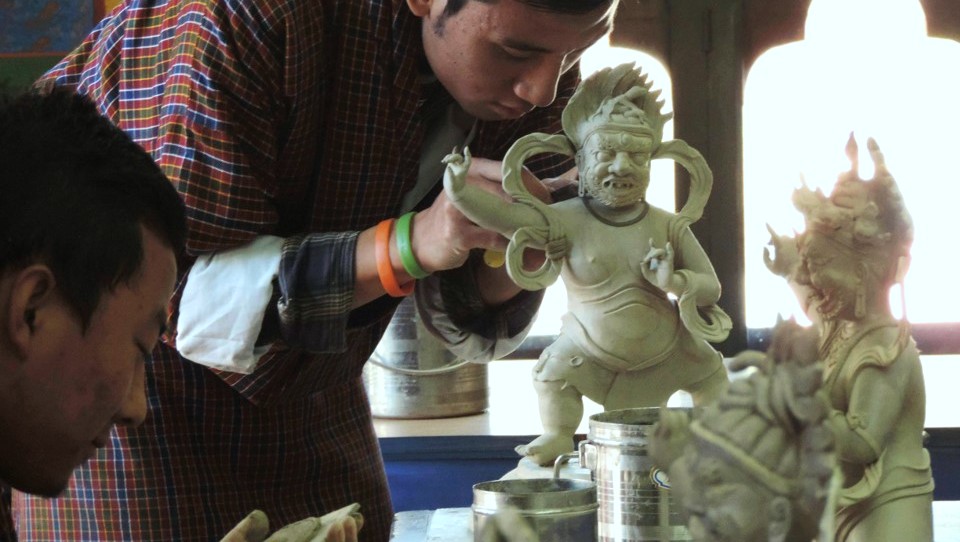
- Religious and Cultural Significance: Metalwork in Bhutan is deeply intertwined with the country’s religious practices. Artisans create a variety of ritual objects such as bells, dorjes (thunderbolts), prayer wheels, and statues of deities, which are essential for Buddhist rituals and ceremonies.
- Traditional Skills: Bhutanese metal artisans are skilled in techniques like bronze casting and blacksmithing. These age-old methods have been passed down through generations, preserving the authenticity and integrity of this craft.
- Local Materials: Metalworkers often use locally sourced metals, including iron, copper, and bronze, which are revered for their durability and traditional aesthetic. The use of these materials not only supports the local economy but also ensures the environmental sustainability of the craft.
- Artistic Expression: Metalwork in Bhutan transcends mere functionality; it is also a form of artistic expression. Artisans intricately carve and embellish metal surfaces, often incorporating symbolic motifs and designs that reflect Bhutanese culture and beliefs.
- Utilitarian Objects: Beyond religious items, Bhutanese metalworkers also produce a range of utilitarian objects like kitchen utensils, farming tools, and traditional weapons. These items are valued both for their craftsmanship and for their role in daily life.
- Preservation of Craftsmanship: Recognizing the importance of metalwork, several initiatives in Bhutan aim to preserve and promote this craft. These include training programs for young artisans and the inclusion of metalwork in cultural exhibitions and festivals.
- Economic Impact: Metalwork provides a livelihood for many artisans in Bhutan. The unique and high-quality products created are not only used locally but are also exported, contributing to the country’s economy.
- Tourist Attraction: For tourists, Bhutanese metalwork offers a unique insight into the kingdom’s artisanal heritage. The opportunity to observe artisans at work and to purchase handcrafted metal items makes this craft a popular attraction.
Bhutanese metalwork is a beautiful representation of the country’s rich cultural heritage and artisanal skills, embodying both the spiritual and practical aspects of Bhutanese life.
Pottery
Pottery in Bhutan is a revered craft that reflects the country's deep-rooted traditions and the artisanal skills passed down through generations. Here are the key highlights of Bhutanese pottery:
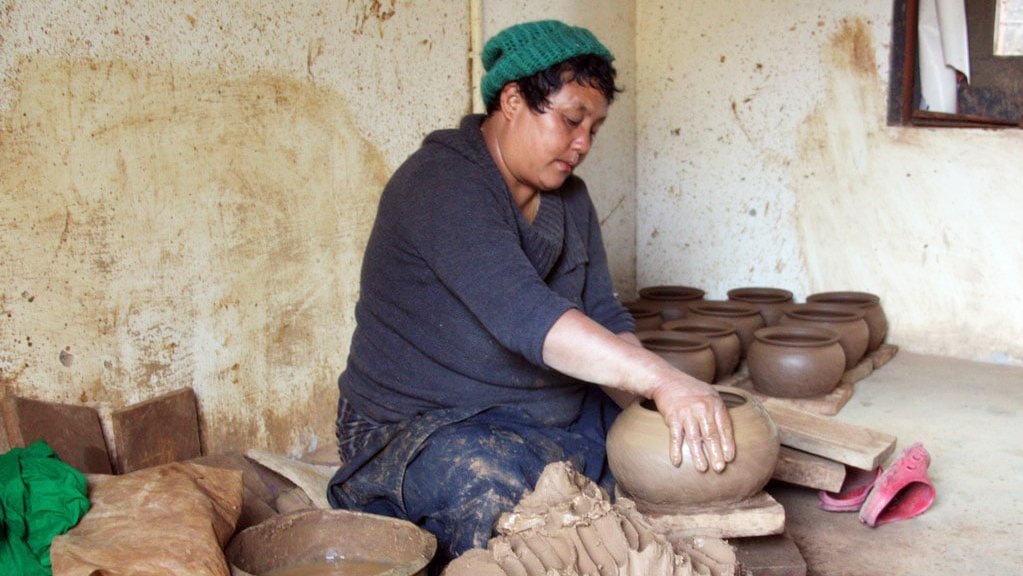
- Traditional Techniques: Unlike many cultures that use the potter's wheel, Bhutanese pottery is traditionally hand-built. This includes techniques like pinching, coiling, and slab construction. The absence of the wheel emphasizes the skill and patience required to shape each piece by hand.
- Cultural Significance: Pottery in Bhutan holds significant cultural value. It is often used in daily life as well as in religious and ceremonial settings. Traditional pots, bowls, and other earthenware are integral to Bhutanese rituals and festivities, underscoring their importance in preserving cultural identity.
- Local Materials: Bhutanese potters use locally sourced clay, which is often collected from specific regions known for their suitable soil. The use of local materials not only supports the sustainability of the craft but also ensures that the pottery retains a distinct Bhutanese character.
- Firing Techniques: Traditional Bhutanese pottery is typically fired in open bonfires or simple kilns. This method can influence the final appearance of the pottery, giving it a unique, rustic look that is highly valued both locally and internationally.
- Artistic Expression: Bhutanese pottery is not just functional; it is also a form of artistic expression. Artisans often decorate their creations with natural pigments before firing, adding intricate patterns and designs that enhance the aesthetic appeal of the pottery.
- Preservation of Tradition: Pottery making is one of the oldest crafts in Bhutan, and there is a concerted effort to preserve this tradition. This includes passing down skills within families and communities, as well as more formal educational programs that aim to revive and sustain pottery as a living art form.
- Economic Role: For many rural communities in Bhutan, pottery is a significant source of income. The craft not only supports local economies but also contributes to the tourism industry, as visitors are keen to purchase authentic Bhutanese pottery as a unique souvenir.
- Tourist Attraction: Pottery workshops are popular attractions for tourists visiting Bhutan. These workshops offer visitors a chance to see artisans at work and to learn about the traditional methods and cultural significance of Bhutanese pottery.
Bhutanese pottery is a testament to the country’s commitment to preserving its heritage crafts. Each piece of pottery not only tells a story of traditional craftsmanship but also showcases the unique cultural identity of Bhutan.
Jewelry Making
Jewelry Making in Bhutan is a fine art that combines traditional skills with cultural significance, producing pieces that are not only beautiful but also rich in symbolism. Here are the key highlights of Bhutanese jewelry making:
.jpg)
- Cultural and Spiritual Significance: Jewelry in Bhutan often bears deep spiritual and cultural meanings. Many pieces are designed with symbols such as the dorje (thunderbolt), lotus, and other Buddhist motifs. These symbols are believed to offer protection, good fortune, and spiritual benefits to the wearer.
- Traditional Techniques: Bhutanese artisans use age-old techniques in their jewelry making, including metal forging, engraving, and filigree. These techniques have been passed down through generations and are highly valued for their ability to produce intricate and delicate designs.
- Materials Used: The materials commonly used in Bhutanese jewelry include gold, silver, bronze, and precious stones. Artisans often source local materials, adding a unique Bhutanese touch to each piece. The use of turquoise and coral is particularly prominent, reflecting the natural beauty and color seen across Bhutan.
- Handcrafted Artistry: Each piece of jewelry is handcrafted, ensuring that no two pieces are exactly alike. This handcrafting process is not only a testament to the skill of the artisans but also makes each piece uniquely personal.
- Integration with Traditional Attire: Bhutanese jewelry is often worn with traditional attire on special occasions and festivals. Pieces like necklaces, earrings, and bracelets enhance the intricate patterns of Bhutanese textiles, creating a harmonious and visually striking ensemble.
- Preservation of Craftsmanship: Recognizing the importance of jewelry making, initiatives in Bhutan aim to preserve this craft through workshops and apprenticeships. These programs help ensure that the skills required for jewelry making are not lost and continue to be a vibrant part of Bhutanese culture.
- Economic Impact: Jewelry making provides an important source of income for many artisans in Bhutan. The trade not only supports individual craftsmen and their families but also contributes to the broader economy through both local sales and exports.
- Tourist Attraction: Bhutanese jewelry is highly sought after by tourists, who appreciate the craftsmanship and cultural stories embedded in each piece. Buying Bhutanese jewelry allows visitors to take home a piece of Bhutanese heritage and art.
Jewelry making in Bhutan is more than just a craft; it is a celebration of Bhutanese culture, art, and spirituality. The meticulous care put into each piece reflects a deep respect for the traditions that have shaped this craft for centuries.
The Local Handicrafts of Bhutan represent a profound blend of tradition, artistry, and cultural heritage. Each craft, whether it be intricate textiles, detailed thangka paintings, handcrafted pottery, or exquisite jewelry, embodies the spiritual and historical ethos of Bhutan. These crafts not only provide a livelihood for many artisans but also play a crucial role in preserving the kingdom's unique traditions and promoting sustainable practices. As such, Bhutanese handicrafts are not merely products; they are cherished pieces of Bhutan's cultural identity, offering insight and connection to the rich tapestry of this Himalayan nation. Through these crafts, Bhutan continues to share its legacy and artistic brilliance with the world.
FAQs on Local Handicrafts of Bhutan
Q: What are the most popular handicrafts in Bhutan?
A: The most popular Bhutanese handicrafts include textiles (such as Yathra and Kiras), thangka paintings, woodwork, bamboo crafts, handmade paper (Deh-sho), metalwork, pottery, and traditional jewelry. Each of these crafts reflects a specific aspect of Bhutanese culture and history.
Q: Where can I buy authentic Bhutanese handicrafts?
A: Authentic Bhutanese handicrafts can be purchased at local craft markets, boutiques, and specialty shops throughout Bhutan. Popular markets include the National Handicrafts Emporium and weekend markets in Thimphu. Many of these items are also available at tourist sites and directly from artisan workshops.
Q: How are Bhutanese handicrafts made?
A: Bhutanese handicrafts are typically made using traditional methods passed down through generations. These methods emphasize handwork and the use of local materials. For example, textiles are handwoven on backstrap looms, thangka paintings are meticulously painted by hand, and pottery is formed without the use of a potter’s wheel.
Q: Are there any workshops or tours focused on Bhutanese handicrafts?
A: Yes, there are several workshops and tours available that focus on Bhutanese handicrafts. These often include visits to artisan workshops where visitors can see craftspeople at work and sometimes participate in making a craft themselves. Such experiences provide deeper insights into the skills and traditions involved.
Q: Why are Bhutanese handicrafts important?
A: Bhutanese handicrafts are important for several reasons: they preserve and promote Bhutanese culture and traditions, support local economies, and offer sustainable employment opportunities. Handicrafts are also integral to Bhutan's tourism industry, providing visitors with unique, high-quality souvenirs.
Q: How do I care for Bhutanese handicrafts?
A: Care for Bhutanese handicrafts depends on the material and craft type. For textiles, avoid direct sunlight and consider gentle hand-washing or dry cleaning. Wooden and bamboo items should be kept dry and cleaned with a soft cloth. Metal objects might require polishing to prevent tarnish, and paper items should be stored away from moisture and light.
Q: Can Bhutanese handicrafts be customized?
A: Many Bhutanese artisans are willing to customize their crafts according to specific requirements, especially for items like textiles, jewelry, and metalwork. Customizations can include personal designs, sizes, and the incorporation of specific symbols or materials.
Q: What makes Bhutanese handicrafts unique?
A: The uniqueness of Bhutanese handicrafts lies in their deep cultural roots, the use of local materials, and the traditional techniques that are employed in their creation. Each piece tells a story of Bhutan’s heritage and reflects the meticulous craftsmanship that has been refined over centuries.
If you are looking for tour packages in Bhutan please click here
If you need any further information, please contact us, Email: at [email protected] , Phone (Whatsapp or Viber) +975-1755-6636
